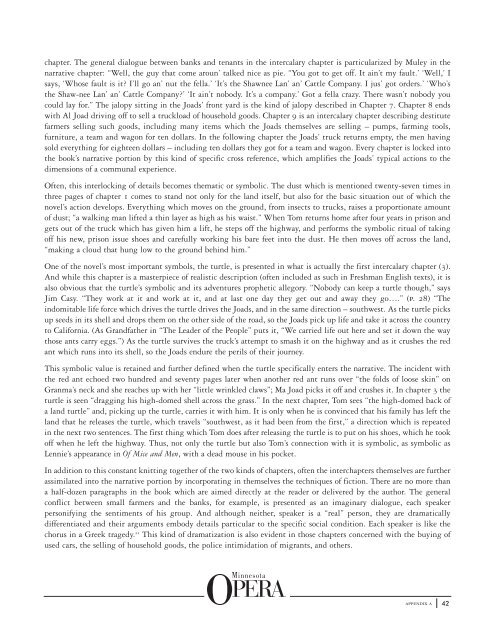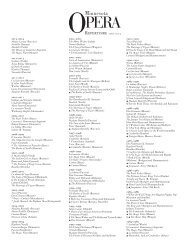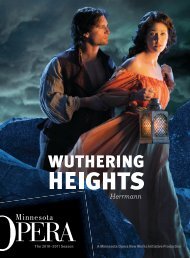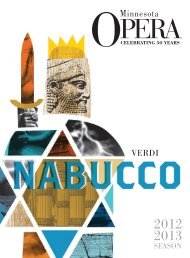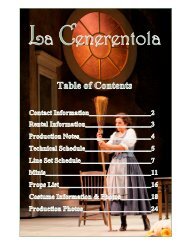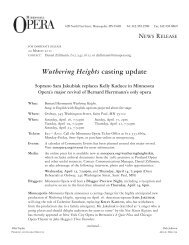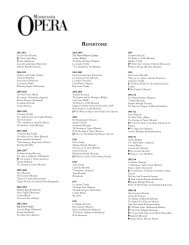You also want an ePaper? Increase the reach of your titles
YUMPU automatically turns print PDFs into web optimized ePapers that Google loves.
chapter. The general dialogue between banks and tenants in the intercalary chapter is particularized by Muley in the<br />
narrative chapter: “Well, the guy that come aroun’ talked nice as pie. “You got to get off. It ain’t my fault.’ ‘Well,’ I<br />
says, ‘Whose fault is it? I’ll go an’ nut the fella.’ ‘It’s the Shawnee Lan’ an’ Cattle Company. I jus’ got orders.’ ‘Who’s<br />
the Shaw-nee Lan’ an’ Cattle Company?’ ‘It ain’t nobody. It’s a company.’ Got a fella crazy. There wasn’t nobody you<br />
could lay for.” The jalopy sitting in the Joads’ front yard is the kind of jalopy described in Chapter 7. Chapter 8 ends<br />
with Al Joad driving off to sell a truckload of household goods. Chapter 9 is an intercalary chapter describing destitute<br />
farmers selling such goods, including many items which the Joads themselves are selling – pumps, farming tools,<br />
furniture, a team and wagon for ten dollars. In the following chapter the Joads’ truck returns empty, the men having<br />
sold everything for eighteen dollars – including ten dollars they got for a team and wagon. Every chapter is locked into<br />
the book’s narrative portion by this kind of specific cross reference, which amplifies the Joads’ typical actions to the<br />
dimensions of a communal experience.<br />
Often, this interlocking of details becomes thematic or symbolic. The dust which is mentioned twenty-seven times in<br />
three pages of chapter 1 comes to stand not only for the land itself, but also for the basic situation out of which the<br />
novel’s action develops. Everything which moves on the ground, from insects to trucks, raises a proportionate amount<br />
of dust; “a walking man lifted a thin layer as high as his waist.” When Tom returns home after four years in prison and<br />
gets out of the truck which has given him a lift, he steps off the highway, and performs the symbolic ritual of taking<br />
off his new, prison issue shoes and carefully working his bare feet into the dust. He then moves off across the land,<br />
“making a cloud that hung low to the ground behind him.”<br />
One of the novel’s most important symbols, the turtle, is presented in what is actually the first intercalary chapter (3).<br />
And while this chapter is a masterpiece of realistic description (often included as such in Freshman English texts), it is<br />
also obvious that the turtle’s symbolic and its adventures prophetic allegory. “Nobody can keep a turtle though,” says<br />
Jim Casy. “They work at it and work at it, and at last one day they get out and away they go….” (p. 28) “The<br />
indomitable life force which drives the turtle drives the Joads, and in the same direction – southwest. As the turtle picks<br />
up seeds in its shell and drops them on the other side of the road, so the Joads pick up life and take it across the country<br />
to California. (As Grandfather in “The Leader of the People” puts it, “We carried life out here and set it down the way<br />
those ants carry eggs.”) As the turtle survives the truck’s attempt to smash it on the highway and as it crushes the red<br />
ant which runs into its shell, so the Joads endure the perils of their journey.<br />
This symbolic value is retained and further defined when the turtle specifically enters the narrative. The incident with<br />
the red ant echoed two hundred and seventy pages later when another red ant runs over “the folds of loose skin” on<br />
Granma’s neck and she reaches up with her “little wrinkled claws”; Ma Joad picks it off and crushes it. In chapter 3 the<br />
turtle is seen “dragging his high-domed shell across the grass.” In the next chapter, Tom sees “the high-domed back of<br />
a land turtle” and, picking up the turtle, carries it with him. It is only when he is convinced that his family has left the<br />
land that he releases the turtle, which travels “southwest, as it had been from the first,” a direction which is repeated<br />
in the next two sentences. The first thing which Tom does after releasing the turtle is to put on his shoes, which he took<br />
off when he left the highway. Thus, not only the turtle but also Tom’s connection with it is symbolic, as symbolic as<br />
Lennie’s appearance in Of Mice and Men, with a dead mouse in his pocket.<br />
In addition to this constant knitting together of the two kinds of chapters, often the interchapters themselves are further<br />
assimilated into the narrative portion by incorporating in themselves the techniques of fiction. There are no more than<br />
a half-dozen paragraphs in the book which are aimed directly at the reader or delivered by the author. The general<br />
conflict between small farmers and the banks, for example, is presented as an imaginary dialogue, each speaker<br />
personifying the sentiments of his group. And although neither, speaker is a “real” person, they are dramatically<br />
differentiated and their arguments embody details particular to the specific social condition. Each speaker is like the<br />
chorus in a Greek tragedy. 22 This kind of dramatization is also evident in those chapters concerned with the buying of<br />
used cars, the selling of household goods, the police intimidation of migrants, and others.<br />
appendix a<br />
42


